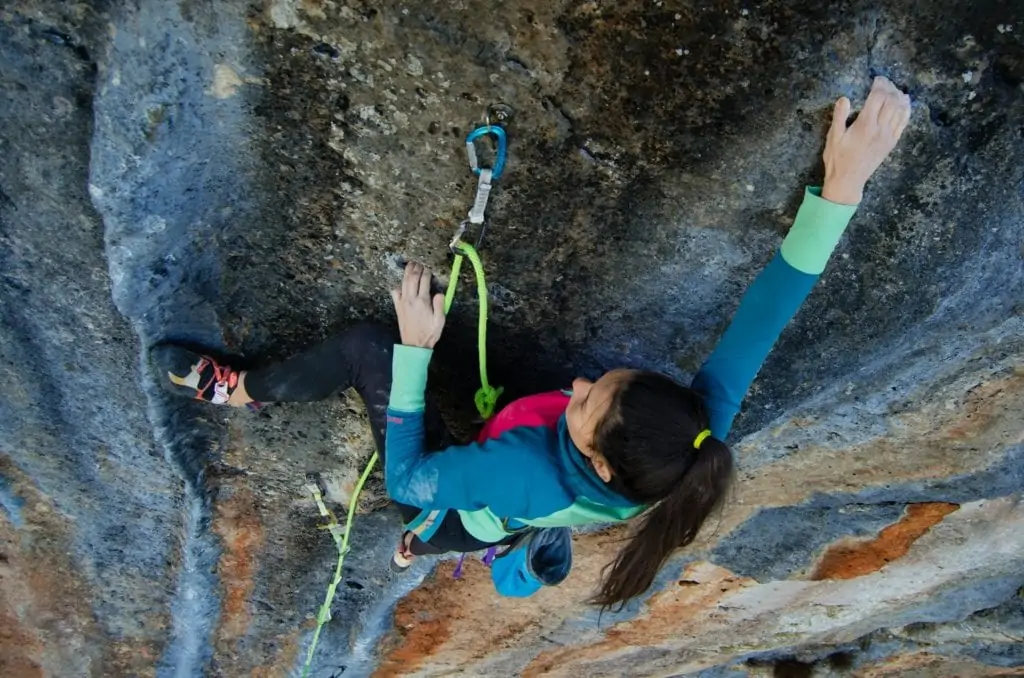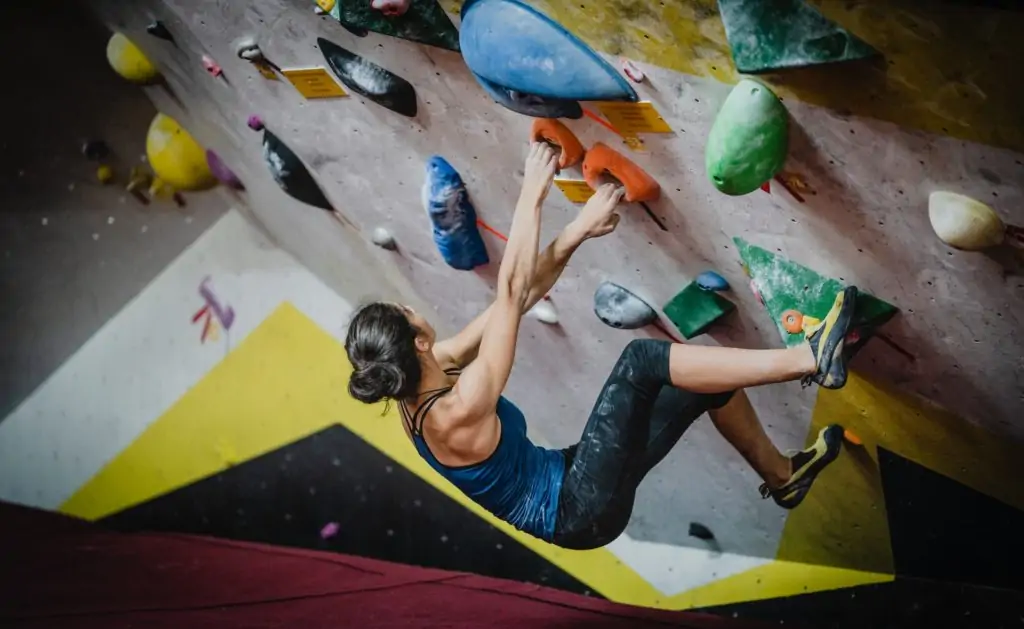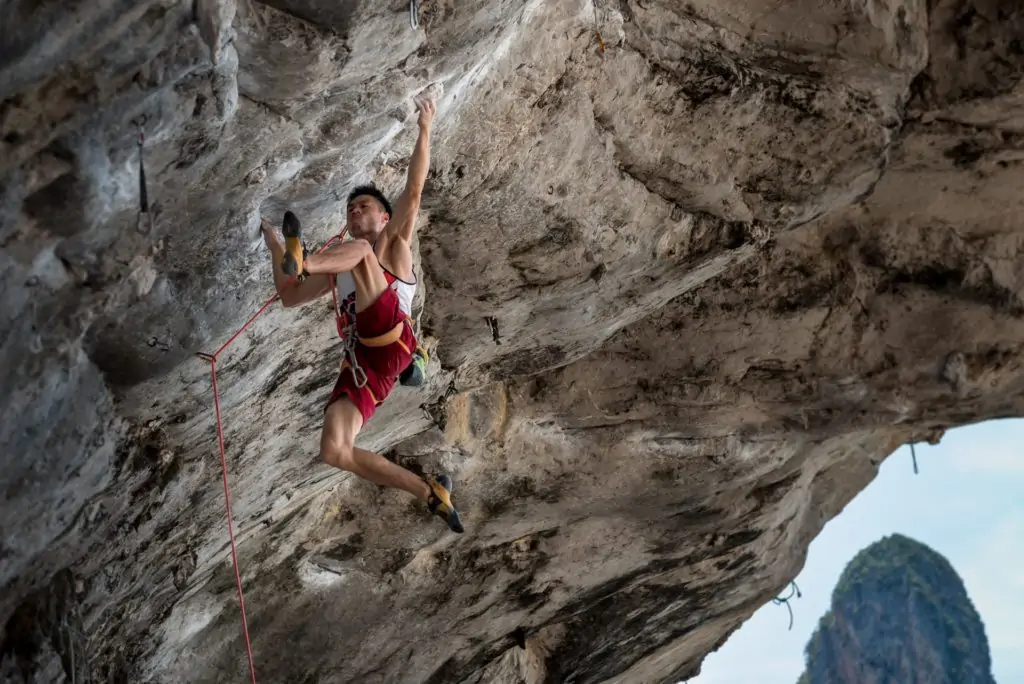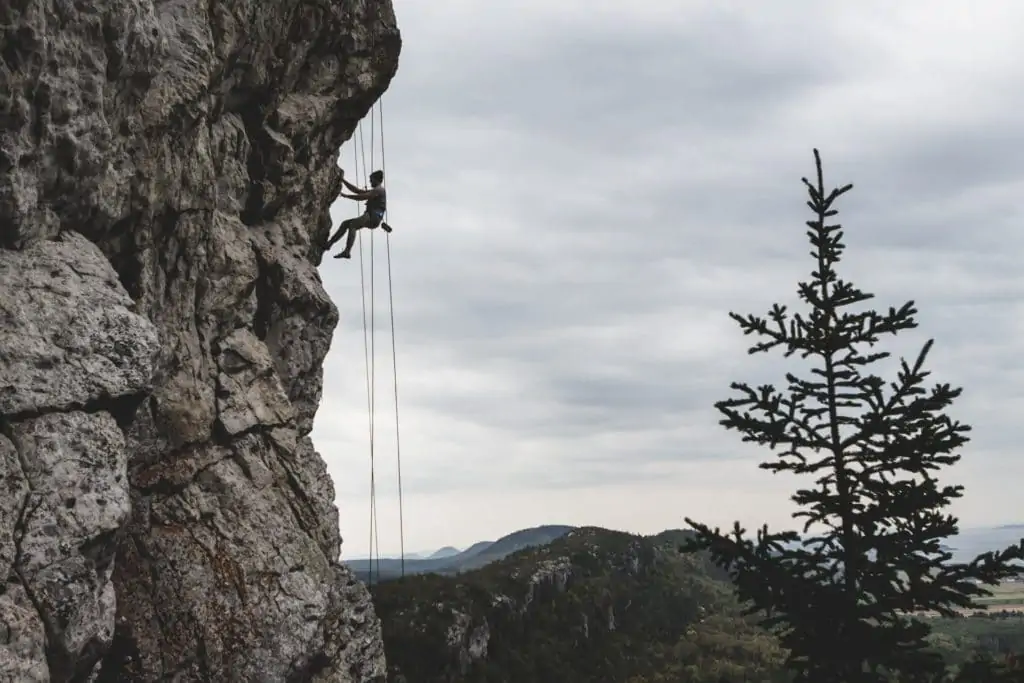Have you ever thought to yourself, “What is the trick to getting better at rock climbing?” We’ve all been at the climbing gym, desperately trying to hold on while our arms scream out in pain. Here’s the thing, there’s a lot to rock climbing. It’s a world unto itself with all the jargon, gear, and techniques. We’ve created a list of rock climbing fundamentals for beginners and intermediate climbers that should get your climbing stoke going for the rock climbing gym and the local crag. If you are starting to work on your first climbs or jumping on V5s these are the rock climbing pointers for you. These rock climbing tips are guaranteed to make you into a better climber so that you can crush your next project or fly through the next crux of a climb.
 General Rock Climbing Tips for Beginners
General Rock Climbing Tips for Beginners
1. Get proper instruction. Here’s the thing. Climbing requires a lot of specific gear and techniques to stay safe, and the best way to learn is to get face to face with someone who knows what they are doing. Some people do this by taking a class at the local climbing gym where they first teach you how to climb on top rope. These skills include how to use a rope, tie into your harness, belay, lower, and climb safely. Another way to do this is to find a mentor; this can be a friend that can show you the ropes (literally) or you can hire a guide who can mentor you through the beginning stages of your climbing career.
2. Climbing is about good technique. One of the first things you may notice when they go into the gym is how many people have rippling back and arm muscles. Don’t be intimidated. While climbing does require physical fitness, good technique is crucial when starting to climb. Anyone can climb up to 5.10 or V3 only using good technique (yes, I genuinely mean anyone, including your grandmother). Excellent rock climbing advice then is to focus on getting smarter by using good feet, body positioning, and hand technique BEFORE concentrating on getting stronger. It is incredible how much less physical effort climbing takes with good technique.
3. Get the right fitting shoes. The standard advice for beginners is to get the tightest possible climbing shoe, even if it means that it hurts a little. This is wrong. While having a tight-fitting shoe is essential for climbing well, if the shoe hurts your feet while you are climbing it is too tight. It will demotivate you to use proper foot technique as putting weight on your feet will hurt, and it is harder to focus when in pain. These will both decrease how well you climb and how much fun you are having.
4. Not all climbing shoes are the same. It seems like an obvious rock climbing tip, but each different pair of climbing shoes is designed for a specific style of climbing. Bouldering shoes will generally be stiffer, and the toe will be more bent in the shoe allowing for boulderers to step on smaller edges – though they come at the cost of being less comfortable. Whereas route climbing shoes will generally be softer and more suitable for climbing all day and fit better into cracks. Check if the designed use of the climbing shoe matches the style you would like to climb. If you want an all-purpose shoe, lean towards less aggressive and softer shoes.
5. Double-check before you climb. We can’t stress this enough. Double-check each other’s knot, harness, locking carabiner and belay device before the climber starts ascending. Most accidents that happen in climbing are preventable, and safety should always be the priority.
6. Don’t be intimidated. It can be easy to feel like your out of place when athletic climbers are climbing hard routes right next to you, screaming as they grab tiny hold that would be barely suitable for ants. Climbing is an individual sport, and YOUR body, technique, and mental strength are going to be different than anyone else’s. And that’s okay! One rock climbing pointer is to go and do your own thing. Honestly, no one cares if you fall off the easiest problem in the gym. Everyone is there to have fun.
7. Learn the language of climbing. There’s a lot of lingo that you will hear tossed around the crag. It envelopes everything from the different technical gear, techniques, quality of rock, how people climb, and how people fall. Learning the language will invariably give you some rock climbing tips and tricks as you will find new ways to interact with the rock walls. Here is a list of some climbing terms you might overhear.
8. Learn the climbing grades. Every style of climbing has a different grade system associated with it. Roped climbs are generally rated with the Yosemite decimal system which goes from 5.0 to 5.15a. The bouldering grading system uses a V grade system ranging from V0-V16.
9. Climbing is going to be hard. The sport can be frustrating. While It can be scary, physically taxing, and mentally draining its essential to enjoy the process. Learn to embrace physical discomfort. The climbing community calls this type-two fun. Type two fun is where it might not be enjoyable in the moment, but the story afterward will be incredible. It can be fun to suffer!
10. Get a guide book when going to the crag. There are lots of different kinds of climbing guide books. Some guide books describe the climbs in a particular area while others describe climbing techniques, while others explain how to use ropes and the technical skills of climbing. All of these are invaluable resources and will make you more successful as a climber. Local climbing guides are the local sacred texts of the climbing world, and will have lots of rock climbing tips!
 Climbing Gym Etiquette for Beginners
Climbing Gym Etiquette for Beginners
11. It is okay to be a beginner and to ask others for help. This is especially true when bouldering. If you are having a hard time figuring out a bouldering problem, ask someone for advice who has climbed the route before or who is stronger. Most people will be more than happy to give you rock climbing advice and beta on the route.
12. Make sure that your route isn’t crossing other climbers’ routes. With climbing gyms getting more and more popular, you must respect other climber’s space. It’s first a safety concern, and secondly, no one wants to be climbed into. Talk with the climbers around you and communicate to take turns.
13. Heads up when bouldering. Pay attention to people above and around you when you are bouldering. You do not want to be underneath someone if they fall off of there boulder problem. Likewise, when you are about to start a bouldering problem, make sure that the area under the route is clear.
14. Learn what type of chalk is allowed in your gym. Each gym is different in which kind of chalk the gym allows. Some don’t allow loose chalk, or only allow chalk balls or liquid chalk. Chalk from loose chalk bags gets in the air and clogs AC systems, so make sure that you check the rules at your local gym.
15. Don’t spray beta. Beta spraying is where someone gives advice on how to climb a route. It is bad form to give unsolicited advice. Part of the enjoyment of climbing is problem-solving and its seen as bad form to tell people how to climb without them asking first. We feel this is an especially good indoor rock climbing tip as there tend to be more people who wish to share their opinions.
16. Take turns at the boulder wall. If it’s busy at the climbing wall, be courteous and take turns on the section of the bouldering wall. Generally, if you stand up and take a step towards the wall, it will let other people around you know that you are ready to climb next.
17. Grunt, but not too much. Let’s be honest, it feels good to yell or grunt when making a tough move on a climbing wall. It is also a legitimate technique that will give you a little more power. Keep it in check though as it tends to ruin the experience of climbers around you.
18. Be aware that other people might want to use your rope. When rope climbing, don’t monopolize a route. The unspoken etiquette is that if people are waiting to climb, you and your partner should take no more than one lap up each. Being aware of who else might want to climb your route makes sure that everyone at the gym gets to climb. Also, ask people if they are finished with a route or rope before jumping on it as they may just be switching climbers.
19. On using the restroom. We are going to cover some bathroom etiquette. First, you should never walk in the bathroom in your climbing shoes. Those climbing shoes eventually end up where people’s hands are. Secondly, wash your hands. A climbing gym is a great place to share climbs, but there are some things better left unshared.
20. Be respectful of people’s experience. As climbing gyms grow more popular, climbing is becoming more and more of a social sport. Try to be a positive member of the community by being encouraging and respectful when other people are climbing.
 Technique Tips for Rock Climbing Beginners
Technique Tips for Rock Climbing Beginners
21. Keep your arms straight. One important rock climbing tip is keeping your arms straight when you climb. It will allow you to keep your weight on your skeletal structure so that you wear out your muscles slower. This is especially important on longer and more overhung routes when you are using your arms more. No T-Rex arms. Period.
22. Keep your hips into the wall. Keeping your hips into the wall while climbing as it keeps your weight over your feet. Keeping your hips in will decrease the amount of weight you have to hold with your hands. This technique is most useful when climbing vertical and overhanging routes.
23. Use your feet correctly. When using your feet, you want to be stepping on holds with your toes or balls of your feet. This will allow you to put more weight onto the foothold. It is also essential to think of climbing as stepping up the climb with your feet rather than pulling up with your arms.
24. Find your center of balance. Climbing is all about balance. The more you can keep your weight over your feet, the more successful you will be as a climber. Practice this by focusing on where your hips are when you climb as they dictate where your center of gravity will be. Keeping your center of mass low on climbing holds, especially slopers, will give you more grip to move upwards.
25. Get out and climb. The only way to get better at climbing is to go out and climb. Focus on mileage rather than difficulty when you climb. Climbing is about teaching your body a new language, and getting on as many different types and styles of climbs will progress your climbing more than anything else will.
26. Watch other people climb. When at the gym, watch the people who are climbing above your current climbing grade. Try to notice how they move their body and use handholds. It can also be beneficial to watch a good climber climb a route before you and then try to repeat the same body movements as them.
27. Engage your core. Your core is what connects all of your movements. When you make a long-reaching move, notice how your abs will engage to join that movement with your feet. Every move in climbing will be transferred through your core muscles. Engaging your core effectively allows you to stay on the wall better, use smaller hand/footholds, and reach farther. A good rock climbing pointer is then always to try to keep your abs tight while on the wall.
28. Get used to lots of different styles. It’s easy in climbing to always do the same kind of routes. The rock climbing routes that we tend to do the most are the styles that we are already comfortable with. The more variety in routes that you get, the better climber you will become. Climbing the things that make you struggle will invariably strengthen your weakest techniques.
29. Ask for advice and beta. If you are struggling on a route, ask for help from another climber. They may see a different way up the route or see something that you don’t. It can also make it more fun to work through a climbing route with a partner, and they can help you keep the stoke high. This is not just a good rock climbing tip for beginner climbers, but even excellent climbers ask for advice all the time.
30. Learn to fall safely bouldering. We all fall, but there are ways to be safer about it. First, make sure that your climbing area is clear before you start climbing. If possible, downclimb as much as possible before jumping down. Try to land on your feet and keep your knees bent. Never try to catch yourself with your arms as it won’t help, and it’s a good way to injure yourself. Never climb above a height that you feel comfortable with and build up your confidence with falling gradually.
 Technique Tips for Intermediate Rock Climbers
Technique Tips for Intermediate Rock Climbers
31. Climb, a lot. Until you are consistently climbing 5.12 or V5, the best way to get better is going to be climbing. Aim to climb three to four times a week. Focus the majority of your time doing lots of easy to moderate climbs as opposed to working on a few harder climbs. Focusing on your climbing mileage will build up your base, which is vital to progressing through the grades.
32. Hangboarding. You should not hangboard until you are climbing around 5.12 or V5 as it is a VERY EASY way to injury yourself as your tendons won’t be strong enough yet. That being said, hangboarding is a great way to improve your grip strength. Follow this link for an in-depth look on how to hangboard.
33. Core strength. As we have already talked about, engaging our core is how we transfer energy through our body when we climb. Training core is a fast way to improve the stability of your body on the wall. With a stronger core, we can connect our handholds to our footholds and thereby keep more tension on the wall. Complex movements that involve the entire body tend to be better than isolated exercises like crunches. Here is an article that explains an excellent core workout regiment.
34. Brush off the holds. Climbing holds will eventually build up grim a build-up of chalk, climbing shoe rubber, dirt and oil from climbers hands. This grim will make the holds harder to hold and use. Use a climbing brush to clean off holds to make them more grippy when trying harder routes. This can be an especially good indoor rock climbing tip as the routes in the gym tend to get more traffic.
35. Resting on route. Learning to rest on a route will allow you to climb longer and harder routes. An excellent way to practice is by predetermining places to stop on a route with positive holds, then stopping on the holds and resting for up to one minute. When resting, keep your arms straight and your hips into the wall — trade which hand is on the hold and shake out both arms above your head. Shaking out your arms above your head will help decrease the amount of lactic acid in your arms, allowing you to recover better.
36. Shake out in between moves. People often think of shaking out as finding a good rest hold and staying there for an extended period. You can also shake out when you are on the move. Every time you reach for a hold, with your free hand, give it a couple of shakes. Those intermediary shakes will eventually add up, and allow you to climb longer without a rest.
37. Breathe. It seems obvious, right? Though when climbers are making hard moves, they hold their breath to maintain core tension. If you can practice breath when climbing harder moves, it will make your body less tense, and allow you to move through moves better. Breathing relaxes your central nervous system, which is in charge of body movements, and breathing also fuels your muscles for aerobic movement. When climbing focus on the exhale, and maintaining solid even breathes.
28. Positive self talk. Climbing is at least 50% a mental game. Between falling, self-doubt, physical discomfort, and problem-solving if you can improve how you think, you can improve your climbing. Create a mantra for a climb and repeat it to yourself. You can use phrases as generic as “I can make this move” to specific ideas like “If I keep good feet, I can make it through the crux.”
39. Learn more advanced climbing techniques. There is more than just grabbing holds on a wall and pulling up. Some more advanced climbing techniques include knowing about cross positioning on overhangs, flagging, how to hold a crimp, how to hold a slopper, gastoning, and dynoing.
40. Learn to lead. Starting to lead climb is always a big jump in climbing as it involves the risk of falling relatively far with no rope above you. Most climbing gyms teach lead climbing classes where they teach you to lead climb. These classes will include intermediate rock climbing tips like how to lead belay, how to clip, back-clipping, Z-clipping, keeping the rope from behind your feet, how to manage rope drag, how to set up an anchor and how to take lead falls safety
 Final Tips for Climbers to Climb Harder and Smarter
Final Tips for Climbers to Climb Harder and Smarter
41. Don’t always climb at your max. Climbing is hard! It wears down your tendons, muscles, and saps our mental strength. Because of that, it is not wise to climb as hard as you can all the time as it can lead to injury, and generally will lead to a plateau and stagnation in climbing progression. Always have a rest day after you climb at your max and never aim to climb multiple days at your max in a week. The trick to progressing as an athlete is getting lots of moderate climbs for your ability in and only spending about ten percent of your time trying at your max.
42. Rest. Resting is just as crucial to climbing as training is. Training and climbing are where our bodies grow weaker, and resting is where they become stronger. If you never take the time for your body to recover, you will eventually start climbing worst, and it will ultimately lead to injury.
43. Refuel. I know climbers tend to be nothing but muscle and sinew, but that doesn’t mean they don’t eat. Before you start climbing, make sure that you eat a variety of fats, carbohydrates, and proteins. While climbing, quick sugars like energy bars or goos will allow you to keep your blood sugar up so that you continually pull hard moves. Lastly, in the first thirty minutes after a hard climbing session, eat complex carbs and protein as it will help with muscle recovery. We go over the best snacks for climbing here.
44. Visualize before you climb. Before attempting a hard climb run through all of the moves of the climb beforehand. Imagine yourself making the moves and what the body positioning is going to be. This visualization will help prepare your mind and your body to know what to expect before you jump on the climb.
45. Take the fall. One of the hardest things to learn is to trust the rope, especially with lead falls. One way to help your fear of falling is to fall on purpose. Tell your partner that you are going to take an unannounced fall on the route, then without telling them choose a safe place on the wall to fall. Once you reach that hold, let go. It will do wonders for your head game and to know that your partner will catch you.
46. Find a good partner. Climbing is truly a partner sport. Find a partner that makes you excited to go climbing and keeps the stoke up. The right partner will push you to climb harder and can teach you new things about the sport. It’s also essential that they are safe as you are relying on them as much as they are counting on you.
47. Wait for good temperatures. If you are struggling on a project outside, it can be beneficial to climb when it’s cold out. Climbing shoes are stickiest when it is 45 degrees, and your hands won’t sweat, making the climbing holds more positive. To get good temperatures climb early in the morning, find shade, or wait for a colder season to attempt the climb.
48. Slow down. Lots of people when climbing indoors will rush through their climbs as fast as possible to stave off the pump. When you hurry through a climb, you often sacrifice technique and the opportunity to build endurance. Slowing down will also make reading the route easier so that when you do get to the crux section, you can have a game plan.
49. Practice both dynamic and static movement. There is always more than one way to do a climb. Try doing climbs both dynamically, with big, quick, powerful movements and statically, with slow, methodical, and thoughtful movements. Different climbs will lend themselves to individual styles, and practicing both will make you stronger.
50. Having fun will make you a stronger climber. It’s easy to get laden down with training or get frustrated while falling off of the same climb over and over. It is easiest to learn when you are having fun. Make climbing a game and if you find yourself getting flustered, step away. It keeps you stoked on climbing, and the positive mental attitude can go a long way to find success with climbing.
Conclusion
That’s a wrap! Today we’ve gone over 50 rock climbing tips and tricks so that you can crush your next project at the indoor climbing gym or climbing outside. There is no way to get better at climbing other than getting on the wall, immersing yourself in the community and getting after it. Remember always to stay safe, use protection, and if you did the first two, take the whip.
If you enjoyed this post, learn all you need to know about 4x4s in this post to take your climbing training up a notch.
Be sure to also check our selection of climbing tips here.
> 15 Climbing Core Workout Tips
> How to Become a Better Climber When You’re First Starting Out

 General Rock Climbing Tips for Beginners
General Rock Climbing Tips for Beginners
 Climbing Gym Etiquette for Beginners
Climbing Gym Etiquette for Beginners
 Technique Tips for Rock Climbing Beginners
Technique Tips for Rock Climbing Beginners
 Technique Tips for Intermediate Rock Climbers
Technique Tips for Intermediate Rock Climbers
 Final Tips for Climbers to Climb Harder and Smarter
Final Tips for Climbers to Climb Harder and Smarter


